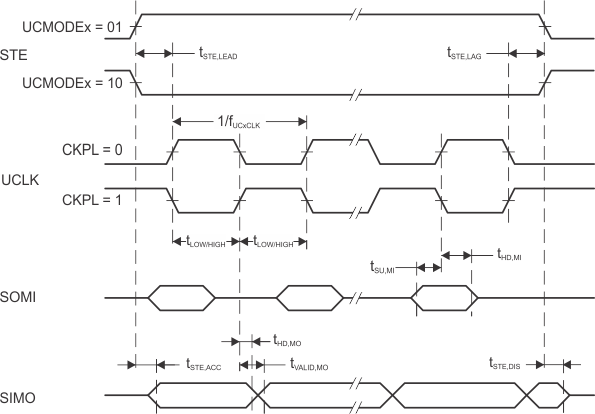SLASEO5D March 2019 – September 2021 MSP430FR2672 , MSP430FR2673 , MSP430FR2675 , MSP430FR2676
PRODUCTION DATA
- 1 Features
- 2 Applications
- 3 Description
- 4 Functional Block Diagram
- 5 Revision History
- 6 Device Comparison
- 7 Terminal Configuration and Functions
-
8 Specifications
- 8.1 Absolute Maximum Ratings
- 8.2 ESD Ratings
- 8.3 Recommended Operating Conditions
- 8.4 Active Mode Supply Current Into VCC Excluding External Current
- 8.5 Active Mode Supply Current Per MHz
- 8.6 Low-Power Mode LPM0 Supply Currents Into VCC Excluding External Current
- 8.7 Low-Power Mode (LPM3, LPM4) Supply Currents (Into VCC) Excluding External Current
- 8.8 Low-Power Mode LPMx.5 Supply Currents (Into VCC) Excluding External Current
- 8.9 Typical Characteristics – Low-Power Mode Supply Currents
- 8.10 Current Consumption Per Module
- 8.11 Thermal Resistance Characteristics
- 8.12 Timing and Switching Characteristics
-
9 Detailed Description
- 9.1 Overview
- 9.2 CPU
- 9.3 Operating Modes
- 9.4 Interrupt Vector Addresses
- 9.5 Bootloader (BSL)
- 9.6 JTAG Standard Interface
- 9.7 Spy-Bi-Wire Interface (SBW)
- 9.8 FRAM
- 9.9 Memory Protection
- 9.10
Peripherals
- 9.10.1 Power-Management Module (PMM)
- 9.10.2 Clock System (CS) and Clock Distribution
- 9.10.3 General-Purpose Input/Output Port (I/O)
- 9.10.4 Watchdog Timer (WDT)
- 9.10.5 System (SYS) Module
- 9.10.6 Cyclic Redundancy Check (CRC)
- 9.10.7 Enhanced Universal Serial Communication Interface (eUSCI_A0, eUSCI_B0)
- 9.10.8 Timers (TA0, TA1, TA2, TA3 and TB0)
- 9.10.9 Hardware Multiplier (MPY)
- 9.10.10 Backup Memory (BAKMEM)
- 9.10.11 Real-Time Clock (RTC)
- 9.10.12 12-Bit Analog-to-Digital Converter (ADC)
- 9.10.13 eCOMP0
- 9.10.14 CapTIvate Technology
- 9.10.15 Embedded Emulation Module (EEM)
- 9.11
Input/Output Diagrams
- 9.11.1 Port P1 (P1.0 to P1.7) Input/Output With Schmitt Trigger
- 9.11.2 Port P2 (P2.0 to P2.7) Input/Output With Schmitt Trigger
- 9.11.3 Port P3 (P3.0 to P3.7) Input/Output With Schmitt Trigger
- 9.11.4 Port P4 (P4.0 to P4.7) Input/Output With Schmitt Trigger
- 9.11.5 Port P5 (P5.0 to P5.7) Input/Output With Schmitt Trigger
- 9.11.6 Port P6 (P6.0 to P6.2) Input/Output With Schmitt Trigger
- 9.12 Device Descriptors
- 9.13 Memory
- 9.14 Identification
- 10Applications, Implementation, and Layout
- 11Device and Documentation Support
- 12Mechanical, Packaging, and Orderable Information
Package Options
Mechanical Data (Package|Pins)
Thermal pad, mechanical data (Package|Pins)
Orderable Information
8.12.7.4 eUSCI (SPI Master Mode)
over recommended ranges of supply voltage and operating free-air temperature (unless otherwise noted)(1)
| PARAMETER | TEST CONDITIONS | VCC | MIN | MAX | UNIT | |
|---|---|---|---|---|---|---|
| tSTE,LEAD | STE lead time, STE active to clock | UCSTEM = 0, UCMODEx = 01 or 10 | 1 | UCxCLK cycles | ||
| UCSTEM = 1, UCMODEx = 01 or 10 | ||||||
| tSTE,LAG | STE lag time, last clock to STE inactive | UCSTEM = 0, UCMODEx = 01 or 10 | 1 | UCxCLK cycles | ||
| UCSTEM = 1, UCMODEx = 01 or 10 | ||||||
| tSU,MI | SOMI input data setup time | 2 V | 58 | ns | ||
| 3 V | 40 | |||||
| tHD,MI | SOMI input data hold time | 2 V | 0 | ns | ||
| 3 V | 0 | |||||
| tVALID,MO | SIMO output data valid time(2) | UCLK edge to SIMO valid, CL = 20 pF | 2 V | 20 | ns | |
| 3 V | 20 | |||||
| tHD,MO | SIMO output data hold time(3) | CL = 20 pF | 2 V | -3 | ns | |
| 3 V | -3 | |||||
(1) fUCxCLK = 1/2tLO/HI with tLO/HI = max(tVALID,MO(eUSCI) +
tSU,SI(Slave), tSU,MI(eUSCI) + tVALID,SO(Slave)).
For the slave parameters tSU,SI(Slave) and tVALID,SO(Slave), see the SPI parameters of the attached slave.
For the slave parameters tSU,SI(Slave) and tVALID,SO(Slave), see the SPI parameters of the attached slave.
(2) Specifies the time to drive the next valid data to the SIMO output after the output changing UCLK clock edge. See the
timing diagrams in Figure 8-13 and
Figure 8-14.
(3) Specifies how long data on the SIMO output is valid after the output changing UCLK clock edge. Negative values
indicate that the data on the SIMO output can become invalid before the output changing clock edge observed on UCLK. Refer to the timing
diagrams in Figure 8-13 and Figure 8-14.
 Figure 8-13 SPI Master Mode, CKPH = 0
Figure 8-13 SPI Master Mode, CKPH = 0 Figure 8-14 SPI Master Mode, CKPH = 1
Figure 8-14 SPI Master Mode, CKPH = 1